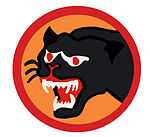66th Infantry Division (United States)
| 66th Infantry Division | |
|---|---|
|
66th Infantry Division shoulder sleeve insignia | |
| Active | 1943–45 |
| Country |
|
| Branch |
|
| Type | Infantry |
| Size | Division |
| Nickname | "Black Panther Division" |
| Engagements | |
| Commanders | |
| April 1943 -August 1945 | Maj. Gen. Herman F. Kramer |
| August 1945 – November 1945 | Maj. Gen. Walter F. Lauer |
| Insignia | |
| Identification symbol | Red bordered circle, containing black panther's head against an orange background |
| US infantry divisions (1939–present) | |
|---|---|
| Previous | Next |
| 65th Infantry Division | 69th Infantry Division |
The 66th Infantry Division was a unit of the United States Army in World War II. It was activated 15 April 1943 at Camp Blanding, Florida. Later it transferred to Camp Robinson, Arkansas where it continued to receive troops and conducted field training. The division's final training post for shipping overseas to Europe Theater of Operations (ETO) was Camp Rucker, Alabama.
Combat chronicle
The three regiments of the 66th Infantry Division arrived in England on 26 November 1944 and the remainder of the division on 12 December 1944, training until 24 December 1944 when the Division crossed the English Channel to Cherbourg on two Belgian steamships, the Chesire and the Leopoldville. A German torpedo ripped into the transport Leopoldville just five miles from its destination of Cherbourg, and 14 officers and 748 enlisted men were lost.
Attached to the 12th Army Group and designated the 12th Army Group Coastal Sector, with operational control of all French forces in the area, the 66th relieved the 94th Infantry Division in the Brittany-Loire area on 29 December 1944. Its mission of containing the enemy in the St. Nazaire and Lorient pockets was carried out by daily reconnaissance patrols, limited objective attacks, and the maintenance of harassing and interdictory fires on enemy installations. A heavy German attack near La Croix was repulsed on 16 April 1945 and several strongly emplaced enemy positions were taken from 19 to 29 April 1945. Enemy troops in the Lorient and St. Nazaire pockets surrendered to the division upon the end of hostilities in Europe on 8 May 1945. The 66th moved to Germany on occupation duty in the Koblenz subarea on 20 May 1945 and left for Marseille on 26 May 1945 in preparation for redeployment to the Pacific.[1] It sailed for home 27 October 1945.
The division consisted of these units:
- 262d Infantry Regiment
- 263d Infantry Regiment
- 264th Infantry Regiment
- HHB Division Artillery
- 721st Field Artillery Battalion (155mm)
- 870th Field Artillery Battalion (105mm)
- 871st Field Artillery Battalion (105mm)
- 872d Field Artillery Battalion (105mm)
- 66th Reconnaissance Troop, Mechanized
- 266th Engineer Combat Battalion
- 366th Medical Battalion
- 66th Counter Intelligence Corps Detachment
- HQ Special Troops
- Hqs Company, 66th Infantry Division
- Military Police Platoon
- 766th Ordnance Light Maintenance Company
- 66th Quartermaster Company
- 566th Signal Company
The 422d and 423d Infantry Regiments (from the 106th Infantry Division) were attached to the division from 15 April to 15 May 1945.[2]
Assignments in European Theater of Operations
- 27 December 1944: 12th Army Group.
- 31 March 1944: Fifteenth Army, 12th Army Group.
General
- Nickname: Black Panther Division
- Shoulder sleeve insignia: The snarling panther suggests the power, aggressiveness and endurance of the Division. The shoulder sleeve insignia was approved on 26 August 1943.
Nicolas Viscardi, the comic book artist who died on Sunday 3 November 2013, served in the United States Army in World War II from 1943 to 1945, earning two Purple Hearts for wounds suffered as a tank driver in the armored cavalry after having begun his military service with the 66th Infantry Division, during which time he won a competition to design its patch, creating its red bordered circle design, containing a black panther's snarling head against an orange background.
References
- The Army Almanac: A Book of Facts Concerning the Army of the United States U.S. Government Printing Office, 1950 reproduced at http://www.history.army.mil/html/forcestruc/cbtchron/cbtchron.html.
